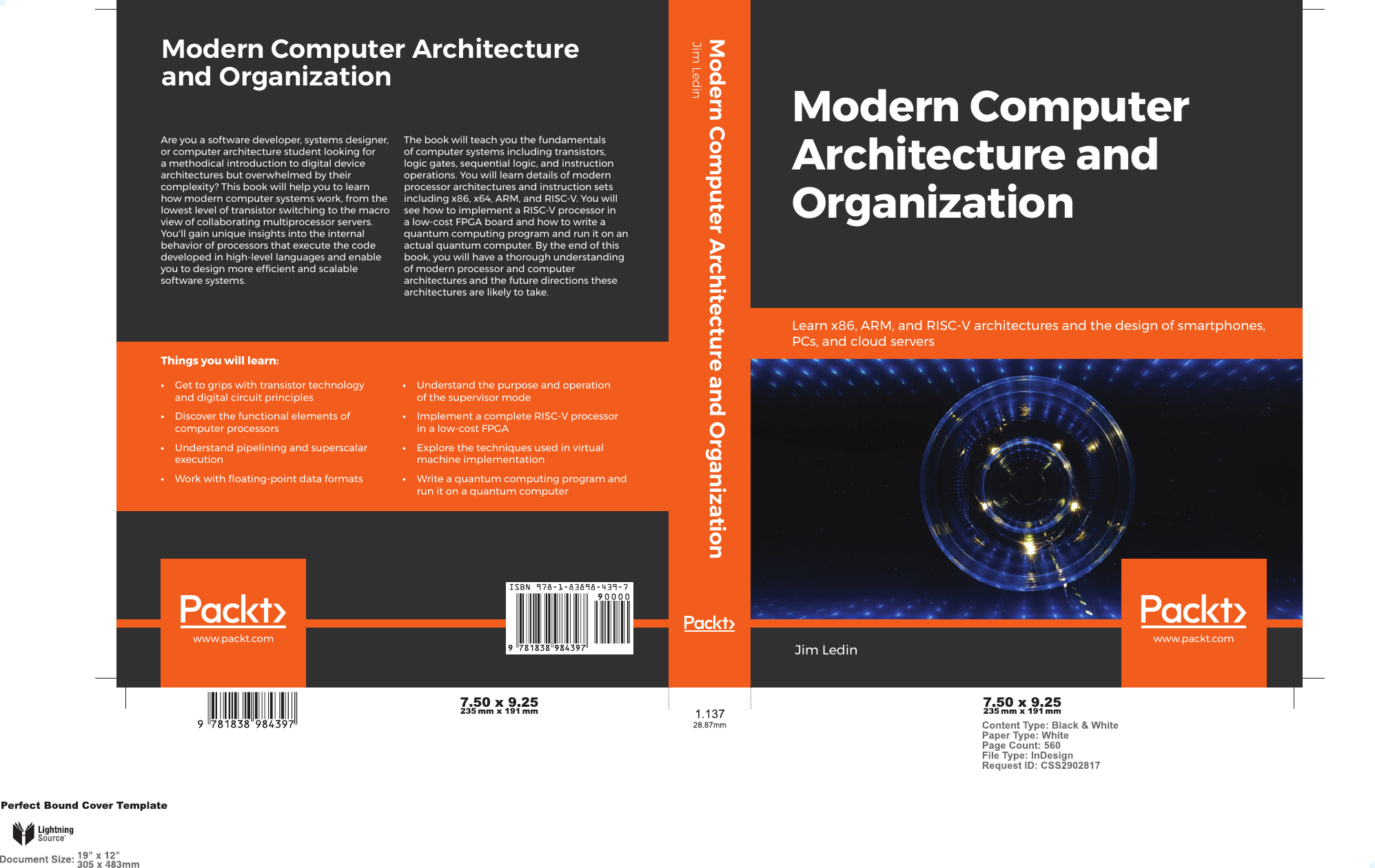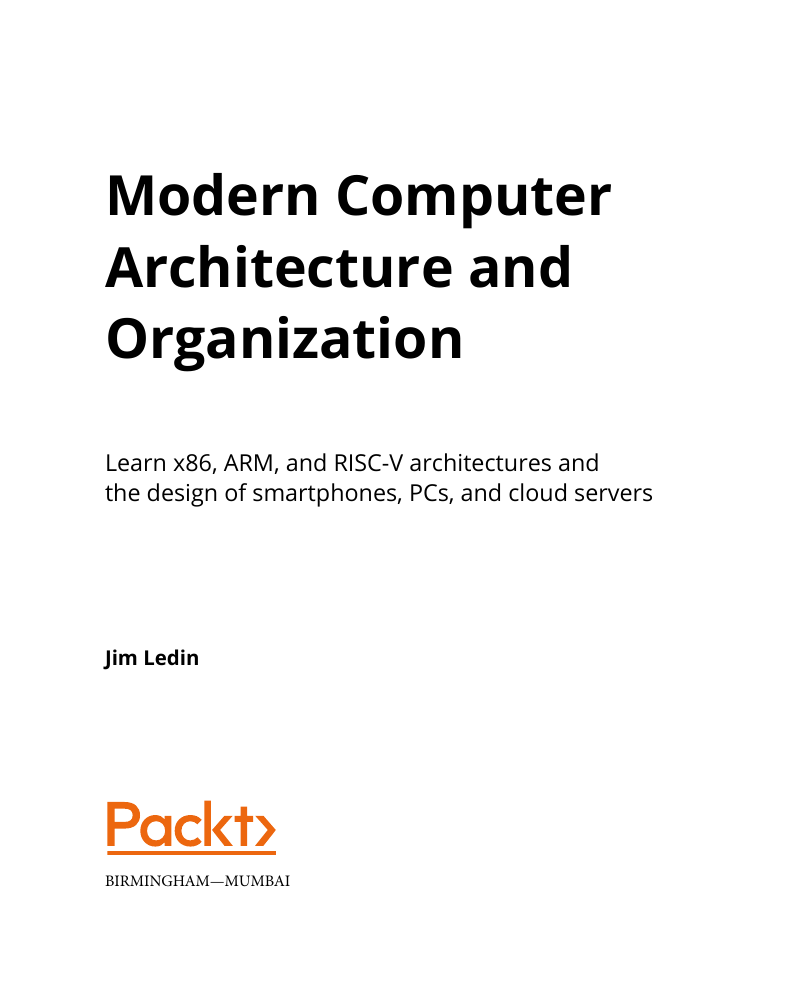Cover
Title Page
Copyright and Credits
About Packt
Contributors
Table of Contents
Preface
Section 1:
Fundamentals of Computer Architecture
Chapter 1: Introducing Computer Architecture
The evolution of automated computing devices
Charles Babbage's Analytical Engine
ENIAC
IBM PC
The iPhone
Moore's law
Computer architecture
Binary and hexadecimal numbers
The 6502 microprocessor
The 6502 instruction set
Summary
Exercises
Chapter 2: Digital Logic
Electrical circuits
The transistor
Logic gates
Latches
Flip-flops
Registers
Adders
Propagation delay
Clocking
Sequential logic
Hardware description languages
VHDL
Summary
Exercises
Chapter 3: Processor Elements
A simple processor
Control unit
Arithmetic logic unit
Registers
The instruction set
Addressing modes
Immediate addressing mode
Absolute addressing mode
Absolute indexed addressing mode
Indirect indexed addressing mode
Instruction categories
Memory load and store instructions
Register-to-register data transfer instructions
Stack instructions
Arithmetic instructions
Logical instructions
Branching instructions
Subroutine call and return instructions
Processor flag instructions
Interrupt-related instructions
No operation instruction
Interrupt processing
IRQ processing
NMI processing
BRK instruction processing
Input/output operations
Programmed I/O
Interrupt-driven I/O
Direct memory access
Summary
Exercises
Chapter 4: Computer System Components
Technical requirements
Memory subsystem
Introducing the MOSFET
Constructing DRAM circuits with MOSFETs
The capacitor
The DRAM bit cell
DDR4 SDRAM
Graphics DDR
Prefetching
I/O subsystem
Parallel and serial data buses
PCI Express
SATA
M.2
USB
Thunderbolt
Graphics displays
VGA
DVI
HDMI
DisplayPort
Network interface
Ethernet
Wi-Fi
Keyboard and mouse
Keyboard
Mouse
Modern computer system specifications
Summary
Exercises
Chapter 5: Hardware-Software Interface
Device drivers
The parallel port
PCIe device drivers
Device driver structure
BIOS
UEFI
The boot process
BIOS boot
UEFI boot
Embedded devices
Operating systems
Processes and threads
Scheduling algorithms and process priority
Multiprocessing
Summary
Exercises
Chapter 6: Specialized Computing Domains
Real-time computing
Real-time operating systems
Digital signal processing
ADCs and DACs
DSP hardware features
Signal processing algorithms
GPU processing
GPUs as data processors
Examples of specialized architectures
Summary
Exercises
Section 2:
Processor Architectures and Instruction Sets
Chapter 7: Processor and Memory Architectures
Technical Requirements
The von Neumann, Harvard, and modified Harvard architectures
The von Neumann architecture
The Harvard architecture
The modified Harvard architecture
Physical and virtual memory
Paged virtual memory
Page status bits
Memory pools
Memory management unit
Summary
Exercises
Chapter 8: Performance-Enhancing Techniques
Cache memory
Multilevel processor caches
Static RAM
Level 1 cache
Direct-mapped cache
Set associative cache
Fully associative cache
Processor cache write policies
Level 2 and level 3 processor caches
Instruction pipelining
Superpipelining
Pipeline hazards
Micro-operations and register renaming
Conditional branches
Simultaneous multithreading
SIMD processing
Summary
Exercises
Chapter 9: Specialized Processor Extensions
Technical requirements
Privileged processor modes
Handling interrupts and exceptions
Protection rings
Supervisor mode and user mode
System calls
Floating-point mathematics
The 8087 floating-point coprocessor
The IEEE 754 floating-point standard
Power management
Dynamic voltage frequency scaling
System security management
Summary
Exercises
Chapter 10: Modern Processor Architectures and Instruction Sets
Technical requirements
x86 architecture and instruction set
The x86 register set
x86 addressing modes
x86 instruction categories
x86 instruction formats
x86 assembly language
x64 architecture and instruction set
The x64 register set
x64 instruction categories and formats
x64 assembly language
32-bit ARM architecture and instruction set
The ARM register set
ARM addressing modes
ARM instruction categories
ARM assembly language
64-bit ARM architecture and instruction set
64-bit ARM assembly language
Summary
Exercises
Chapter 11: The RISC-V Architecture and Instruction Set
Technical requirements
The RISC-V architecture and features
The RISC-V base instruction set
Computational instructions
Control flow instructions
Memory access instructions
System instructions
Pseudo-instructions
Privilege levels
RISC-V extensions
The M extension
The A extension
C extension
The F and D extensions
Other extensions
64-bit RISC-V
Standard RISC-V configurations
RISC-V assembly language
Implementing RISC-V in an FPGA
Summary
Exercises
Section 3:
Applications of Computer Architecture
Chapter 12: Processor Virtualization
Technical requirements
Introducing virtualization
Types of virtualization
Categories of processor virtualization
Virtualization challenges
Unsafe instructions
Shadow page tables
Security
Virtualizing modern processors
x86 processor virtualization
ARM processor virtualization
RISC-V processor virtualization
Virtualization tools
VirtualBox
VMware Workstation
VMware ESXi
KVM
Xen
QEMU
Virtualization and cloud computing
Summary
Exercises
Domain-Specific Chapter 13: Computer Architectures
Technical requirements
Architecting computer systems to meet unique requirements
Smartphone architecture
iPhone X
Personal computer architecture
Alienware Aurora Ryzen Edition gaming desktop
Ryzen 9 3950X branch prediction
Nvidia GeForce RTX 2080 Ti GPU
Aurora subsystems
Warehouse-scale computing architecture
WSC hardware
Rack-based servers
Hardware fault management
Electrical power consumption
The WSC as a multilevel information cache
Neural networks and machine learning architectures
Intel Nervana neural network processor
Summary
Exercises
Chapter 14: Future Directions in Computer Architectures
The ongoing evolution of computer architectures
Extrapolating from current trends
Moore's law revisited
The third dimension
Increased device specialization
Potentially disruptive technologies
Quantum physics
Spintronics
Quantum computing
Carbon nanotubes
Building a future-tolerant skill set
Continuous learning
College education
Conferences and literature
Summary
Exercises
Answers to Exercises
Chapter 1, Introducing Computer Architecture
Exercise 1
Answer
Exercise 2
Answer
Exercise 3
Answer
Exercise 4
Answer
Exercise 5
Answer
Exercise 6
Answer
Chapter 2, Digital Logic
Exercise 1
Answer
Exercise 2
Answer
Exercise 3
Answer
Exercise 4
Answer
Exercise 5
Answer
Exercise 6
Answer
Chapter 3, Processor Elements
Exercise 1
Answer
Exercise 2
Answer
Exercise 3
Answer
Exercise 4
Answer
Exercise 5
Answer
Exercise 6
Answer
Chapter 4, Computer System Components
Exercise 1
Answer
Exercise 2
Answer
Chapter 5, Hardware-Software Interface
Exercise 1
Answer
Exercise 2
Answer
Chapter 6, Specialized Computing Domains
Exercise 1
Answer
Exercise 2
Answer
Exercise 3
Answer
Chapter 7, Processor and Memory Architectures
Exercise 1
Answer
Exercise 2
Answer
Exercise 3
Answer
Chapter 8, Performance-Enhancing Techniques
Exercise 1
Answer
Exercise 2
Answer
Exercise 3
Answer
Chapter 9, Specialized Processor Extensions
Exercise 1
Answer
Exercise 2
Answer
Exercise 3
Answer
Exercise 4
Answer
Exercise 5
Answer
Exercise 6
Answer
Exercise 7
Answer
Exercise 8
Answer
Chapter 10, Modern Processor Architectures
and Instruction Sets
Exercise 1
Answer
Exercise 2
Answer
Exercise 3
Answer
Exercise 4
Answer
Exercise 5
Answer
Exercise 6
Answer
Exercise 7
Answer
Exercise 8
Answer
Chapter 11, The RISC-V Architecture and Instruction Set
Exercise 1
Answer
Exercise 2
Answer
Exercise 3
Answer
Exercise 4
Answer
Chapter 12, Processor Virtualization
Exercise 1
Answer
Exercise 2
Answer
Exercise 3
Answer
Chapter 13, Domain-Specific Computer Architectures
Exercise 1
Answer
Exercise 2
Answer
Chapter 14, Future Directions in Computer Architectures
Exercise 1
Answer
Exercise 2
Answer
Exercise 3
Answer
Exercise 4
Answer
Other Books You May Enjoy
Leave a review - let other readers know what you think
Index
















 2023年江西萍乡中考道德与法治真题及答案.doc
2023年江西萍乡中考道德与法治真题及答案.doc 2012年重庆南川中考生物真题及答案.doc
2012年重庆南川中考生物真题及答案.doc 2013年江西师范大学地理学综合及文艺理论基础考研真题.doc
2013年江西师范大学地理学综合及文艺理论基础考研真题.doc 2020年四川甘孜小升初语文真题及答案I卷.doc
2020年四川甘孜小升初语文真题及答案I卷.doc 2020年注册岩土工程师专业基础考试真题及答案.doc
2020年注册岩土工程师专业基础考试真题及答案.doc 2023-2024学年福建省厦门市九年级上学期数学月考试题及答案.doc
2023-2024学年福建省厦门市九年级上学期数学月考试题及答案.doc 2021-2022学年辽宁省沈阳市大东区九年级上学期语文期末试题及答案.doc
2021-2022学年辽宁省沈阳市大东区九年级上学期语文期末试题及答案.doc 2022-2023学年北京东城区初三第一学期物理期末试卷及答案.doc
2022-2023学年北京东城区初三第一学期物理期末试卷及答案.doc 2018上半年江西教师资格初中地理学科知识与教学能力真题及答案.doc
2018上半年江西教师资格初中地理学科知识与教学能力真题及答案.doc 2012年河北国家公务员申论考试真题及答案-省级.doc
2012年河北国家公务员申论考试真题及答案-省级.doc 2020-2021学年江苏省扬州市江都区邵樊片九年级上学期数学第一次质量检测试题及答案.doc
2020-2021学年江苏省扬州市江都区邵樊片九年级上学期数学第一次质量检测试题及答案.doc 2022下半年黑龙江教师资格证中学综合素质真题及答案.doc
2022下半年黑龙江教师资格证中学综合素质真题及答案.doc